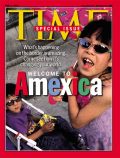The Functions and Effects of Culture |
Page 2 of 2 |
|
|
1) Culture limits and liberates us
2) Culture defines, divides, and unites us
Culture shapes the way we think, feel, and act. And mass media helps create all of our different cultures. |

Click for larger image
©Saturday Evening Post |
Culture Defines, Divides, and Unites
Our dominant culture defines us as a nation. In theory, America is a "melting pot", where people of many different cultures can find common ground. These smaller, "bounded and family cultures" merge to make up the dominant culture.
This film, released two days before Independence Day 2004, attempts to reaffirm the common bond between Americans.
|
But, the "melting pot" nature of society may giving away to the "walled garden" nature.
Rather than assimilate their bounded cultures in the dominant culture, people band together (sometimes physically, sometimes socially) to protect their bounded identity. These walls can exist at both the highest and lowest levels of society. These attempts at isolation will continue to cause friction with those who encourage others to adopt the dominant culture. |
|
What happens when individuals choose to be defined by their bounded culture instead of the dominant one? They can be seen as isolationist, ungrateful, un-American, in rejecting the dominant culture. And to what lengths will they go to preserve their bounded culture? |
 ©2001, Time Magazine ©2001, Time Magazine |
|
At the personal level, "preserving the purity of one's culture" can lead to racism. At the national level, "preserving the purity of a nation's culture" can lead to genocide. Later, we'll look at the attempts by Canada and France to preserve their public culture in the area of global communication.
The ad below has become a national rallying cry for Canadians.
|
|
"Bounded Cultures" are sometimes known as subcultures They distinguish themselves from the "dominant culture" and sometimes oppose it. They create their own rules (sometimes rigid) for acceptance. A "gang" is a bounded culture which places its own rules above the general rules for society. These subcultures form natural "niches" which can be targets for mass media communications.
This ad has a simple theme - wear these pants, attract women. It tailors this generic message to a specific bounded culture.
|
This division by culture has created serious tensions in America. Some people want you to give up your culture and embrace their culture, which they think is the dominant culture. This may help explain the drive behind the "English First" movement. Forcing people to learn and use English is one way of forcing them to abandon their culture (and "rituals") and accept our culture, which we understand.
Following September 11, the ad below helped reaffirm our unity within our diversity.
However, the wars in Afghanistan and Iraq and tension over immigration have reopened long standing divisions within the country.
The political ad, below, affirms a specific interpretation of "dominant" culture by attacking offensive bounded cultures.
This desire for cultural monogamy is not an American phenomenon.
"Arrangements such as special Japanese classes for newcomers are ad hoc and understaffed. Many of
the foreigners aren't entitled to pensions or the same health benefits as Japanese workers because they're
hired through special job brokers.
Above all, the differences are cultural and rife with stereotypes: Latinos playing music late on weekends;
teenagers congregating in the streets at night, alarming police.
'We have people who don't follow the rules,' said Mayor Hasegawa. 'So then we have a lot of cultural friction.'"
Click here to read "Japan Re-Thinking Decision."
Substitute the word "English" for the word "Japanese" and you'll have a good description of our own cultural struggle with Hispanic immigrants. |
| After you've completed this part of Module 2, go to the Assignments page and complete the next Assignments.
|
The Functions and Effects of Culture |
Page 2 of 2 |
|
|
Go back to Part 2 - Developing A Common Culture
Go back to Part 1 - What is Culture? |
This is an official FGCU web page. Revised 01/01/2011
©2011, Terry Dugas
All media, Copyright, respective owners. Media used within copyright Fair Use guidelines as outlined by the University of Texas, Stanford University, and others.
Florida Gulf Coast University is an equal opportunity/affirmative action institution.
|